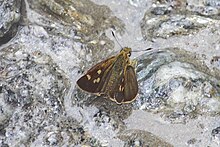|
Pedesta pandita
Pedesta pandita, the brown bush bob, is a species of skipper, a butterfly belonging to the family Hesperiidae. The species was first described by Lionel de Nicéville in 1885.[1] DescriptionThe wingspan of the brown bush bob is 25–30 mm (1.0–1.2 in).[1] In 1891, in his Hesperiidae Indica, Edward Yerbury Watson wrote:
Distribution and habitatThe brown bush bob is distributed from Sikkim to Arunachal Pradesh in India and is also found in Myanmar.[1] The flight of this infrequently seen species is fast and determined but not that fast as other fast-flying skippers. They usually fly close to the ground, and after a quick flight, will settle down in a preferred spot. They are usually spotted in wet soil or damp rock and are also found extracting nutrients from a bird droppings. Occasionally they will bask in the sun, opening their wings half-closed like other skippers. They are predominantly found in the lower elevation forest tracks or sometimes can be spotted near streams or falls.[1] SeasonalityThe brown bush bob is best seen from April to October.[1] References |
||||||||||||||||||||||||||||||||||||

